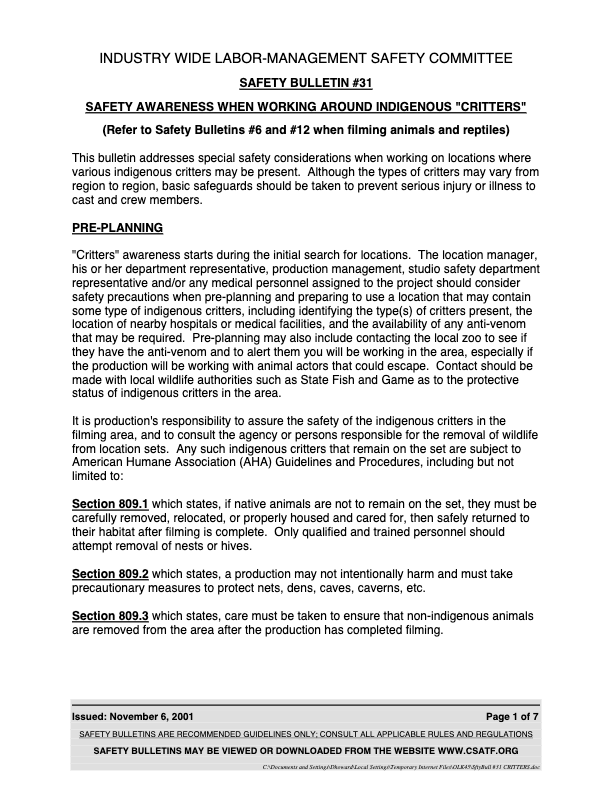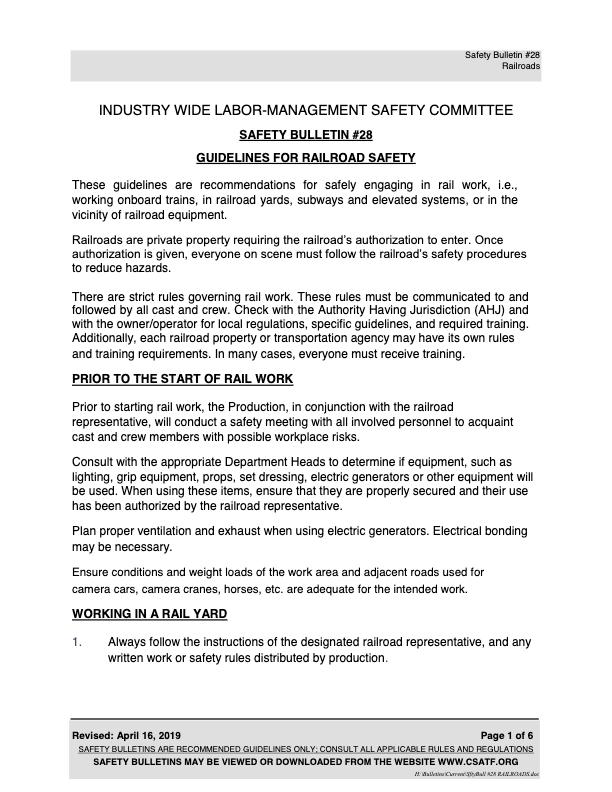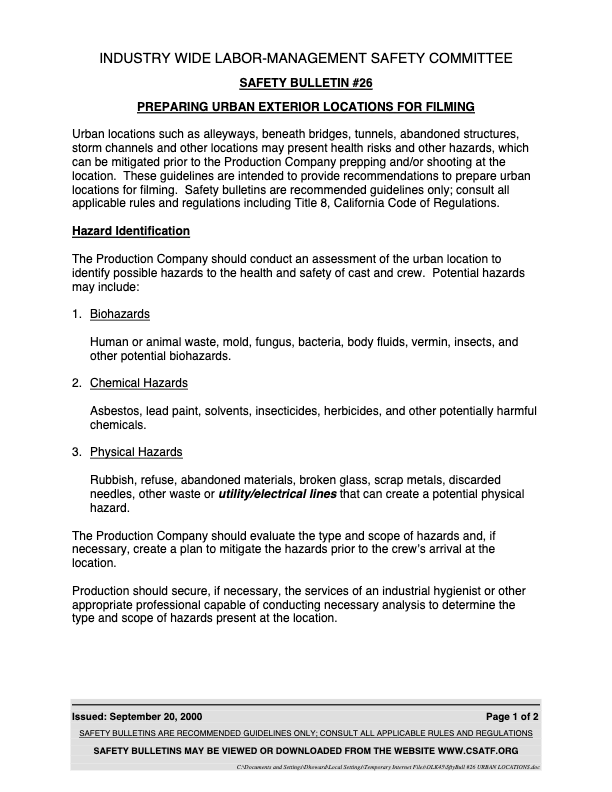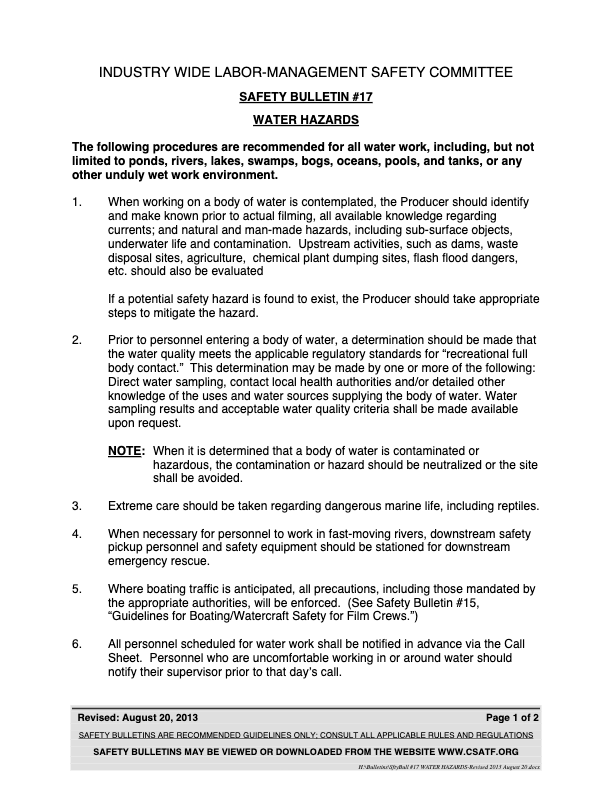Safety Bulletin

Guidelines
This bulletin addresses special safety considerations when working on locations where various indigenous critters may be present. Although the types of critters may vary from region to region, basic safeguards should be taken to prevent serious injury or illness to cast and crew members.
Pre-planning
Critter awareness starts during the initial search for locations. The location manager, his or her department representative, production management, studio safety department representative and/or any medical personnel assigned to the project should consider safety precautions when pre-planning and preparing to use a location that may contain some type of indigenous critters, including identifying the type(s) of critters present, the location of nearby hospitals or medical facilities, and the availability of any anti-venom that may be required. Pre-planning may also include contacting the local zoo to see if they have the anti-venom and to alert them you will be working in the area, especially if the production will be working with animal actors that could escape. Contact should be made with local wildlife authorities such as State Fish and Game as to the protective status of indigenous critters in the area.
It is production’s responsibility to assure the safety of the indigenous critters in the filming area, and to consult the agency or persons responsible for the removal of wildlife from location sets. Any such indigenous critters that remain on the set are subject to American Humane Association (AHA) Guidelines and Procedures, including but not limited to:
- Section 809.1 which states, if native animals are not to remain on the set, they must be carefully removed, relocated, or properly housed and cared for, then safely returned to their habitat after filming is complete. Only qualified and trained personnel should attempt removal of nests or hives.
- Section 809.2 which states, a production may not intentionally harm and must take precautionary measures to protect nets, dens, caves, caverns, etc.
- Section 809.3 which states, care must be taken to ensure that non-indigenous animals are removed from the area after the production has completed filming.
Animal actors brought to a location can be affected by other indigenous critters: this could range from distraction to life threatening situations or the transmittal of diseases between critters. Notification should be provided to the professional trainer/supplier of the animal actors.
If you have additional questions regarding the AHA’s Guidelines for the Safe Use of Animals in Filmed Media, contact the Film and Television Unit at (818) 501-0123.
General Safety Precautions
- While working around critters, it is advisable to wear long pants with the pant legs tucked into socks or boots. A good boot above the ankle will provide better protection. It is also advisable to wear a long-sleeved shirt, dress in layers and wear light colors. Generally, critters are dark in color; they are spotted easily against a light background.
- Avoid heavy perfumes or after-shaves as they attract some pests. Apply repellents according to label instructions on the product. Applying repellents to clothing appears to be most effective.
- If a pesticide is being used to control pests, follow manufacturers’ instructions including the proper use of personal protective equipment (PPE) as noted on the product label and/or Material Safety Data Sheet (MSDS) for persons applying the product or entering the treated area. Allow time for dissipation prior to using a treated location. The MSDS must be available to all cast and crew upon request.
- In the case of bites or stings, serious allergic reactions are possible. If you have any known allergies, notify the set medic and/or safety representative prior to or when you first arrive at the location.
- If you are bitten or stung by an indigenous critter, immediately contact the set medic. If the encounter with the indigenous critter involves a life threatening situation, call 911.
- For additional precautions or questions, contact the studio safety representative, local health department, set medic or local experts in the area you will be working in.
Indigenous Critters
Since there are numerous types of critters, there is no way this Safety Bulletin can cover all of the various types. The following are some of the more commonly encountered critters on locations.
1. Ants
- Are red, brown or black in color and have a three-segment body with six legs
- They are found everywhere and their bites are mild to painful
- Special precautions should be taken when working around red fire ants to keep from being bitten
2. Ticks
- Are red, brown, or black in color and have a hard-shelled body with eight legs
- Some types of ticks are very small in size and difficult to detect
- They are found in open fields, overgrown vegetation, wooded areas, and on or near animals
- Ticks live on deer, mice, and birds
- Do not attempt to remove ticks by using lighted cigarettes, matches, nail polish, or vaseline.
- If bitten, seek medical attention immediately. Ticks are known to carry many types of diseases such as tick paralysis, Lyme disease and Rocky Mountain spotted fever.
3. Scorpions
- Are tan, brown or black in color and have a hard-shelled body with eight legs, claws and a barbed tail
- When a scorpion stings, it whips its tail forward over its head
- They can be found under rocks or fallen wood and are most common in the desert and southwest
- All stings are painful, however, very few are fatal
4. Stinging, Flying Insects (Bees, Hornets and Wasps)
- Are black, yellow, or red in color and have a three-segment body with wings, and a tail stinger
- They can be found everywhere and can produce a mild to painful sting which causes allergic reactions in some
- If stung, seek medical attention and notify the set medic. People who are allergic should carry reaction medication
- Stinging flying insects are generally dormant at night with the exception of mosquitoes
- Identification of Africanized killer bees is very difficult. Remember this type of bee is very aggressive and will attack in swarms. Extreme care should be taken if a hive is located.
5. Biting Insects
- Mosquitoes and Flies
- There are many different species of mosquitoes and flies in the United States. They can be found in wooded areas, near or on animals, refuse areas, or water, particularly standing water.
- These insects can carry various types of diseases. Malaria and dengue fever are not just found in tropical locations, it has been found in the United States. Asian “tiger mosquitoes” have been found in the Los Angeles area and are known to carry dengue fever.
- Chiggers
- Are red, tiny and smear red when crushed
- They are prevalent throughout the southern part of the United States
- They live on the ground, around shrubs and plants, or anywhere vegetation will protect them
- They prefer shade and moist areas, but will forage for food at great distances
- They can also detect a food source from a great distance
- Chigger bites produce blisters by irritating the skin. Use chigger bite ointment to remove the itch and promote healing
6. Poisonous Spiders
- Black Widow Spider
- Are black in color and have a two-segment body with eight legs and a red hour glass design on the abdomen
- They are prominent in warm climates and prefer cool, dry, and dark places
- They can produce painful to fatal bites
- Brown Recluse Spider
- Are brown in color, have a two-segment body with eight legs and a violin shaped design on the abdomen
- They can produce painful to fatal bites
7. Snakes
- Pit Vipers (Rattlesnakes, Copperheads, etc.)
- They come in sixteen (16) distinctive varieties
- There are numerous subspecies and color variations, but the jointed rattles on the tail can positively identify all
- While most are concentrated in the southwest U.S., they have extended north, east, and south in diminishing numbers and varieties so that every contiguous state has one or more varieties
- Pit Vipers produce painful to fatal bites and do not have to be coiled to strike. For example, a rattlesnake can strike out for one-half of its body length
- Other Exotic Snakes
- When working in other foreign locations that have various other exotic snakes indigenous to the area (cobra, black mamba, etc.), these snakes produce fatal bites; therefore, the location of anti-venom is extremely important
- Different anti-venom will be required for various species
- Consult with local experts and governmental authorities
- If Bitten by a Snake
- Seek immediate medical attention
- Attempt to note the time and area of body bitten
- Immediately immobilize the body part affected
- Do not apply a tourniquet, incise the wound, or attempt to suck out the venom
- Do not allow the victim to engage in physical activity
- Tips for Snake Avoidance
- Always look where you are putting your feet and hands
- Never reach into a hole, crevices in rock piles, under rocks, or dark places where a snake may be hiding. If you need to turn over rocks, use a stick
- Attempt to stay out of tall grass, if you can. Walk in cleared spots as much as possible. Step on logs, not over them so that you can first see whether there is a rattlesnake concealed below on the far side
- Be cautious when picking up equipment, coiled cables, and bags left on the ground
- Never pick up a snake or make quick moves if you see or hear a rattle. If bitten by a snake, remember what it looked like. Various snakes require different anti-venoms
- Remember that rattlers are protectively colored (camouflaged)
- On hot summer days, rattlesnakes can become nocturnal and come out at night when you do not expect it. Care should be taken when working at night after a hot summer day
- Other types of snakes indigenous to the United States are cottonmouth and coral snakes. These snakes can produce fatal bites and can become very aggressive
8. Alligator and Crocodiles
- Can be found in various waterways around the world
- They have been known to attack large animals and humans and will exit the water to attack prey on the shoreline
- They can be found in both fresh and salt water
- Both the alligator and crocodile have been known to ambush their victims
9. Sharks, Sea Urchins, Rays, Scorpion Fish, Jellyfish and Other Exotic Marine Life
- When working around water environment, you may contact and consult with local experts, Studio safety representatives or medical staff to become familiar with the critters in or around the water environment in question.
10. Rodents
- Locations that may involve the use of alleyways, beneath bridges, tunnels, abandoned buildings, or other structures, may involve potential contact with rats, squirrels and other rodents
- They can carry various types of diseases, which can be contracted if bitten by one of these critters
- Refer to the Safety Bulletin on “Preparing Urban Locations” for precautions and clean up of locations that may have these types of rodents present




